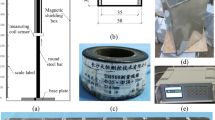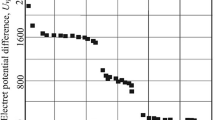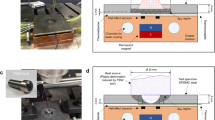Abstract
JUST at the instant of tensile fracture of low-carbon iron specimens a transient magnetic field of the order of 1,000 gauss is produced1. This phenomenon is observed even in the absence of any external magnetic field. Only the surface region of the fractured pieces are magnetised, with the fractured ends exhibiting distinct and opposite polarities. The magnetisation of each piece varies along the length, with maximum at the fractured end. Moreover, the induced magnetisation is retained for about 15 d in larger specimens and then decays almost exponentially. Iron specimens fractured under impact forces did not show any magnetisation. I now report observations of the complementary phenomenon of generation of an electric field at the instant of tensile fracture of metallic specimens, ferromagnetic as well as non-ferromagnetic.
This is a preview of subscription content, access via your institution
Access options
Subscribe to this journal
Receive 51 print issues and online access
$199.00 per year
only $3.90 per issue
Buy this article
- Purchase on Springer Link
- Instant access to full article PDF
Prices may be subject to local taxes which are calculated during checkout
Similar content being viewed by others
References
Misra, A., Indian J. Pure Appl. Phys., 11, 419–421 (1973).
Weiss, R. J., Solid State Physics for Metallurgists, 254 (Pergamon, Oxford 1963).
Nabarro, F. R., Theory of Crystal Dislocations, 510–529 and 613–671 (Oxford University Press, London, 1967).
Author information
Authors and Affiliations
Rights and permissions
About this article
Cite this article
MISRA, A. Electromagnetic effects at metallic fracture. Nature 254, 133–134 (1975). https://doi.org/10.1038/254133a0
Received:
Revised:
Issue Date:
DOI: https://doi.org/10.1038/254133a0
This article is cited by
-
A Review of the Electromagnetic Radiation Emission and Magnetic Field Generation in Metallic Materials Under Stress
Transactions of the Indian Institute of Metals (2024)
-
Monitoring of Crack Initiation at Coating/Substrate Interface by Residual Magnetic Field Measurement
Journal of Nondestructive Evaluation (2021)
-
A review on deformation-induced electromagnetic radiation detection: history and current status of the technique
Journal of Materials Science (2021)
-
Experimental and Theoretical Investigations of Electromagnetic Radiation Emission from Soft and Hard PZT Ceramics
Journal of Electronic Materials (2019)
-
Effect of Low Temperature on Electromagnetic Radiation from Soft PZT SP-5A Under Impact Loading
Journal of Electronic Materials (2018)
Comments
By submitting a comment you agree to abide by our Terms and Community Guidelines. If you find something abusive or that does not comply with our terms or guidelines please flag it as inappropriate.



